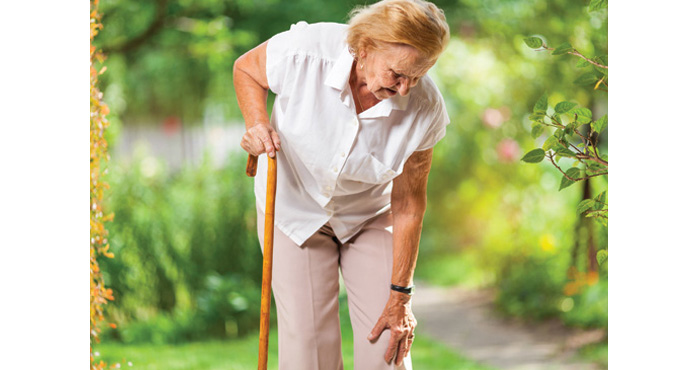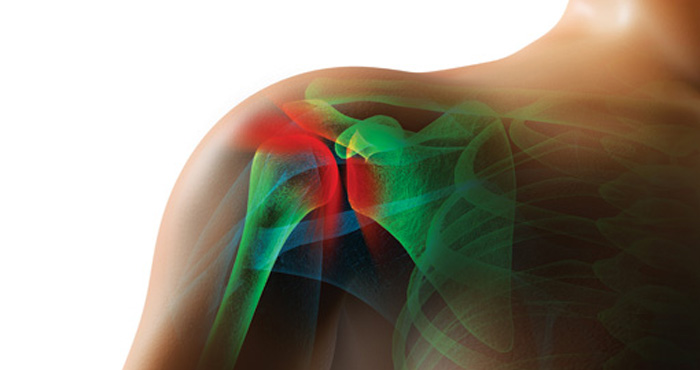Time to think topical
In OTC
Follow this topic
Bookmark
Record learning outcomes
Helping customers choose the right topical analgesic for their individual needs is key if they are to gain optimum benefit

Learning objectives
After reading this feature you should be able to:
- Appreciate how pain can compromise quality of life
- Help customers make good lifestyle choices
- Advise on how to choose topical OTC products to relieve pain
It has been estimated that up to 28 million people in the UK are affected by pain that persists for over three months, while almost one third – some 17.8 million people – live with a musculoskeletal condition such as back pain or arthritis.
“Musculoskeletal pain is likely to affect a significant percentage of the population and encompasses a huge range of conditions,” says Emma Davies, advanced pharmacist practitioner in pain management at Swansea Bay University Health Board and chair of the Primary Care Pharmacy Association pain group. “Low back pain, for example, is acknowledged to be the leading cause of disability worldwide and osteoarthritis is purported to affect 60 per cent of 60-year-olds.”
It is not just older people who are at risk of musculoskeletal pain. “Our research confirms that muscular problems begin much earlier than many of us might imagine, with one in three 18 to 24-year-olds noticing an increase in aches and pains in the past year, and almost one in 10 reporting a significant deterioration,” says Dr Chris Etheridge, a medical herbalist, adviser to Puressentiel and a specialist in this field.
While musculoskeletal conditions and the pain, stiffness and immobility that go with them can compromise the lives of sufferers in many obvious physical ways, Dr Etheridge says mental health and wellbeing is also affected.
“Depression is four times more common in people with pain compared to those without,” he says. “Sufferers may also feel tired and wiped out, lacking in energy, not hungry, have trouble sleeping and suffer mood changes. Musculoskeletal pain can take a toll on self-esteem and, unable to do the things they need to do or enjoy doing, makes suffers feel angry, miserable, demotivated, lacking drive and frustrated.
“They may also experience lack of concentration and poor memory, feel emotionally more sensitive than usual, not be able to stop brooding and have to adopt a different posture when walking – all of these things compromise quality of life.”
Pain management advice
Community pharmacy teams are often the first healthcare personnel people turn to for advice about pain, so it pays to be up to date on current thinking about the best ways to manage musculoskeletal pain as it is so common.
The latest NICE guidance for musculoskeletal pain sufferers is to take exercise and stay active.1 Regular exercise can improve range of movement and joint mobility, increase muscle strength, reduce stiffness and boost energy, and will also help people maintain a healthy weight and ease pressure on their joints.
Staying active is probably the most important piece of advice, says Emma Davies. “This is the one thing that has been shown over and again to have the most benefit in the short- and long-term for any kind of pain. That is not to say that it will cause a reduction in pain, but maintaining activity ensures that muscles and joints do not stiffen up, become deconditioned or weak, which can make ‘getting going again’ when the pain reduces much harder. Also, maintaining movement helps to reassure the nervous system that nothing terrible is happening and can reduce overprotective behaviours, which can be debilitating in the longer term.”
Depression is four times more common in people with pain compared to those without
Tailored treatment
“People will generally feel more positive if they can play a part in managing their condition, so pharmacy teams have a vital role in helping their customers make good lifestyle choices and advising them on how to choose OTC products to help relieve pain,” says Jillian Watt, director of marketing and NPD at Mentholatum.
So is now the time to ‘think topical’ for musculoskeletal pain? Watt says Mentholatum would like to see pharmacists and counter staff helping patients to stop thinking in terms of ‘oral painkillers and rest’, and instead adopt the latest thinking on topical pain relief and keeping active.
She highlights the fact that the NHS Pain Toolkit stresses the importance of getting involved in one’s own care, as well as pointing out the benefits of stretching and strengthening exercises. “People suffering from chronic musculoskeletal pain will welcome advice from pharmacy teams on which products to use for their particular needs and there is still a good deal of work to be done to guide sufferers towards the proper applications for hot, cold and anti-inflammatory products.
“If people need relief over a longer period, they may prefer a topical option, which may be associated with less risk of unwanted gastric side-effects than oral painkillers. Patients who are already taking oral medication for pain or other conditions may need advice on the drug-free options available.”
While often seen as innocuous, topical preparations can still produce systemic side-effects
Mentholatum’s Mind Your Back campaign (mindyourbackuk.com) is an online resource offering advice on managing back pain and helping to avoid further problems, with five S.T.E.P.S. covering Stretching, Therapy, Exercise, Posture and Strengthening.
Easy-to-follow exercises are designed to help aid mobility and develop a stronger core to support the back. Advice is given on maintaining good posture, how exercise can help ease pain and stiffness and manage weight, and there is also guidance on which OTC products are best suited to which type of pain and discomfort.
This is where community pharmacy comes into its own, with tailored advice on pain relief that suits customers, she says. Pharmacy has an important role to “make sure patients understand there are other options apart from oral analgesics, and that these are effective and less likely to cause some of the unwanted effects of longer-term use of some oral products”, says Watt.
While Professor Dame Sally Davies, England’s chief medical officer, agrees that the use of analgesics “can be useful in the short-term to reduce the level of pain being experienced in order to encourage and support the person to remain active”, she stresses that when selling analgesics or making recommendations, “it absolutely must be in conjunction with advice about activity, reducing an individual’s anxiety about pain and [explaining] ‘what it means’ – the likelihood being that it will be self-limiting and improve over a few weeks.”
Key facts
- The demand for topical pain relief is increasing as incidence of chronic pain rises
- Musculoskeletal pain can take a toll on self-esteem
- Managing expectations of treatment is crucial in ensuring positive outcomes
Self-management techniques
Another key to helping customers is to find out “what matters to the person and how they could continue doing those things despite experiencing pain”, says Dame Sally. This could involve suggesting other self-management techniques.
For example, advising customers to practise good posture is important, says Chris Etheridge. “Whilst sitting, it is important to keep the head, shoulders and spine in a vertical line. When lifting, keep the back straight and use the strongest muscles and leg joints rather than bending your back.”
Helping musculoskeletal pain sufferers to relax and improve their mood can also have good results. “Spending time in positive friendships, perhaps starting a new hobby or interest – as energy and pain allow – can be important and help to reduce pain and take the mind away from it,” adds Etheridge, “and it is also essential to tackle sleep problems, which are very likely to occur in people with musculoskeletal pain.
“Sleep reduces the levels of stress hormones, such as cortisol, epinephrine and norepinephrine, while chemicals associated with cell repair and restoration rise. Good sleep hygiene such as having a warm bath before bedtime, a warm non-caffeinated drink and maintaining a good routine around bedtime can be helpful, and lavender essential oil has been shown to address some of the issues associated with musculoskeletal conditions – such as anxiety and pain – which can exacerbate sleep problems. One study found an oral dose of ‘true lavender’ oil was as effective
as a prescribed anti-anxiety medicine.”
Pharmacy teams can also offer advice on what to do if their condition worsens. “Acute pain that is mild to moderate can be safely dealt with in the pharmacy, so identifying the cause and source of the pain is key to the advice that is given,” says Northern Ireland community pharmacist Terry Maguire.
“Acute pain can last 10 to 14 days but is usually resolved in a shorter period when the underlying damage or trauma resolves.

Opioid scripts up 60 per cent
Department of Health and Social Care data reveal that the number of opioid medication prescriptions dispensed in the community has increased by more than 60 per cent over the past 10 years, rising from over 14 million prescription items in 2008 to 23 million last year.
Codeine-related deaths in England and Wales have more than doubled over the same period, with more than 150 fatalities last year. A Public Health England investigation into prescription drug addiction is currently underway, with the findings expected to be published later this year.
Professor Dame Sally Davies, England’s chief medical officer, has stressed that anyone who is prescribed strong painkillers takes them only as long as they are suffering from serious pain.
“As soon as the pain starts to alleviate, the drugs have done their job and it is important to switch to over-the-counter medications like paracetamol,” she says, “which do not carry the same risk of addiction that comes with long-term [opioid] use.”
Failure to properly manage acute pain can lead to chronic pain, and severe pain usually indicates a more serious condition that will often need referral to a GP or A&E.”
Dame Sally says being aware of red flags and when to seek further advice or review is important for pharmacy teams, as “this shows customers that you are taking them seriously, but also that in the first instance they can self-manage in the vast majority of cases.”
Benefits of topical analgesics
With so much information available about managing musculo-skeletal pain, the message about topical pain relief can easily get lost, particularly with those people who have not used topical analgesics before.
When it comes to recommending topical analgesics, Jillian Watt says there are three key benefits to focus on:
- Targeted pain relief that is applied directly at the point of pain
- They do not pass through the major organs and can help avoid unwanted gastrointestinal side-effects associated with the longer-term use of some oral analgesics
- Some offer a number of effective drug-free options, so they can provide relief for people who are already using oral medications.
Cautions and warnings
It is important to be able to advise on which type of product to use to relieve different types of pain and the key differences between products. It is also important that customers are aware that, while often seen as innocuous, topical preparations can still produce systemic side-effects.
“Topical NSAIDs have a reasonable evidence base to support their use,” says Dame Sally. “The evidence suggests diclofenac or ketoprofen might be more effective than other drugs based on short-term, often limited application studies.
“However, systemic adverse effects have been reported for topical NSAIDs and this must be impressed upon people so patients don’t see them as less of a [potential] problem than oral medicines. Topical analgesics should be treated like any oral analgesic and there are dose limits for each topical preparation.
“In addition, they should not be used with oral NSAIDs, although we frequently see them co-prescribed. They can be useful, however, for short periods, perhaps more so than in the long-term, like any analgesic. Certainly when pain is acute, people are more likely to benefit from regular use – up to the dose limit – alongside physical activity.”

Careful application
The method of application should also be a consideration when recommending topical products to customers, especially if a person’s movement is restricted, says Jillian Watt. While creams and gels are popular, sprays can help deliver the active ingredient to hard-to-reach areas, patches offer long-lasting relief, and roll-on products are portable and relatively mess-free.
Consistent – and successful – application is also key. Terry Maguire says the right amount of gel or cream is “normally the amount that would cover a 50 pence piece, rubbed into the painful region”. This should be reapplied as indicated in the instructions, but these can differ. Some need to be reapplied every six hours while others need to be applied every 12 hours.
With so many considerations, helping customers choose the right topical analgesic for their individual needs is key to them gaining optimum benefit. “People may have their own preferences or susceptibility to the effects of each product,” Dame Sally says, “so bear in mind excipients and individual responses to those as well. Price is another consideration for a lot of people, so being able to advise on each different product is important, as well as being able to signpost to other services. For example, a local drop-in physio service would be a great place to refer people for reassurance and advice on remaining active.”
Topical analgesics are not a magic bullet for pain relief, she says. “Like any analgesic, the use of a topical preparation is unlikely to result in total cessation of pain. The idea of using analgesics is to reduce the severity of pain and improve ease of movement. It is really important that we explain this to people, whether they are making a purchase or collecting a prescription, as managing expectations is crucial in ensuring positive outcomes.
“People should know within a couple of days if the preparation is helpful in terms of reducing pain intensity. However, it may take longer to improve their movement and activity, depending on how long someone has been debilitated.”
